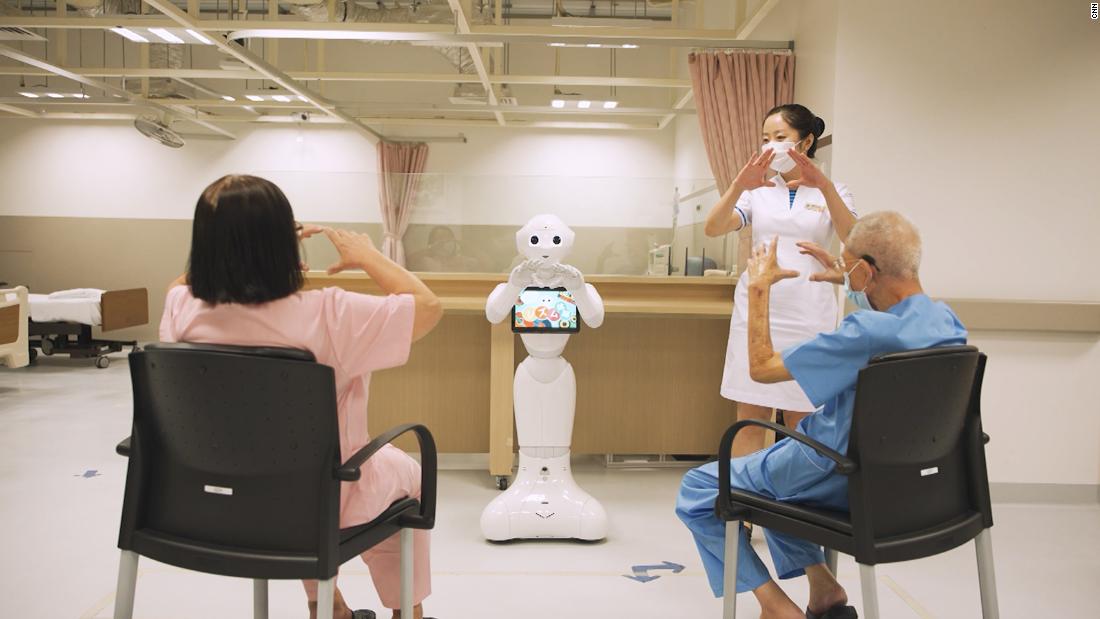Many experiments have proven that robots can treat, assist and protect patients. that technology can generally facilitate access to health care and provide it at a lower cost, and higher quality, and greater security. This prompted the Singapore government to integrate robots into its hospitals to help medical staff carry out various tasks related to patient care and hospital management.
According to estimates by the World Health Organization (WHO), that by 2030, the world will have a deficit of 18 million health-care workers, This has caused great concern in small countries such as Singapore. Which leads the countries of the world in the percentage of reliance on robots, 9 robots per 100 workers, But this is not enough for a country facing the risk of the so-called "Three Tsunamis", which is the aging of the population, and the decline in the number of the workforce, and increased chronic diseases. In fact, Singapore's health system may not be equipped to deal with all these challenges. Especially in view of the enormous human potential it needs, Starting from accomplishing monotonous tasks such as preparing employee work schedules, Down to performing the most complex surgeries, All of them consume time and effort and drain the energy of workers, Nurses develop back and vertebrae problems within a few years of practicing the profession. In parallel with this reality, The COVID-19 pandemic has imposed unprecedented conditions in all fields, with the accompanying distancing measures, These are difficult for health-care providers to adhere to, It turns out that the health system in Singapore has to devise new solutions to provide health care to patients. And that is without a human workforce.
After experimenting with robots in some COVID-19 ward for nursing and care, The Ministry of Health of the Singapore Government, Through its subsidiary SingHealth, By integrating 50 robots into the work system in a hospital, In collaboration with the Healthcare and Robotics Technology Support Center (CHART), which works to employ the latest technologies to find solutions to the challenges of the health sector. The center has adopted the RoMi-H communication system to manage the work of robots, It was programmed to monitor and guide patients, And make night tours to inspect them and respond to their routine or non-urgent requests.
Singh Health has also established automated systems, including monitoring nurses' adherence to hygiene procedures and sterilization standards. Using sensors that measure the distance between the employee and the handwashing corner. The electronic drug system selects, packs and distributes doses with mechanical precision, while a third system schedules work schedules taking into account requirements, experience and efficiency. Furthermore, The hospital uses a system called da Vinci to operate popular surgical robots. It helps the human surgeon to perform surgeries. And outside the operating rooms, Other robots with simple operating systems perform cleaning, clothing delivery, meals, and maintenance tasks.
To improve the work of the cadres, The company has developed programs and technologies to qualify health care providers, For example, she devised a system to train nurses in the process of opening a vein and inserting a tube into the patient's arm. The system relies on a glove whose fabric contains precise sensors that show the amount of pressure applied when the tube is inserted into a three-dimensional model of a human arm. This hypothetical patient can talk to the nurse to put them in front of real-life scenarios.
The hospital administration has also hired social robots such as Barrow to provide care and accompany elderly patients with dementia. And share memory games and group therapy sessions, and relieve stress and anxiety.
Prior to the trial, Doctors have put an important challenge for developers, It is the possibility that elderly patients will not respond to robots as intended. For this reason, They had to design them with sizes and specifications that are comfortable for patients, And when I presented them as human-size toys, They regained the feeling of childhood, Their ability to interact increased and they showed a better therapeutic response compared to human treatment. The government faces the additional challenge of data privacy. Because electronic management systems need very strong digital security against hacking attempts. The challenge, however, is that integrating robots into the workplace requires massive funding and costly infrastructure.
However, the Singapore Government believes that the impact of the experiment is worth meeting the challenges. Especially in difficult circumstances such as the COVID-19 pandemic, At the administrative level, The use of technology to organize the work of employees has saved a lot of time and effort, The automatic adjustment of drug therapy ensures that it runs precisely, This means higher patient safety because it eliminates the possibility of avoidable medical errors; It reduced friction, Social robots have also reduced stress and dependence on tranquilizers in dementia patients. On the other hand, Monitoring hygiene standards is the first step to reducing transmission between health care providers and patients; The use of technological innovations and games to train medical personnel enables them to develop their professional practice and communication skills in a risk-free environment.
In the future, the company plans to use facial recognition technology in the registration processes and identify patients who need emergency care. As well as blockchain technology to prevent drug manipulation, As the next step in the chain of integrating technology and robotics within the health sector.
References:
https://edition.cnn.com/2021/08/25/asia/cgh-robots-healthcare-spc-intl-hnk/index.html






